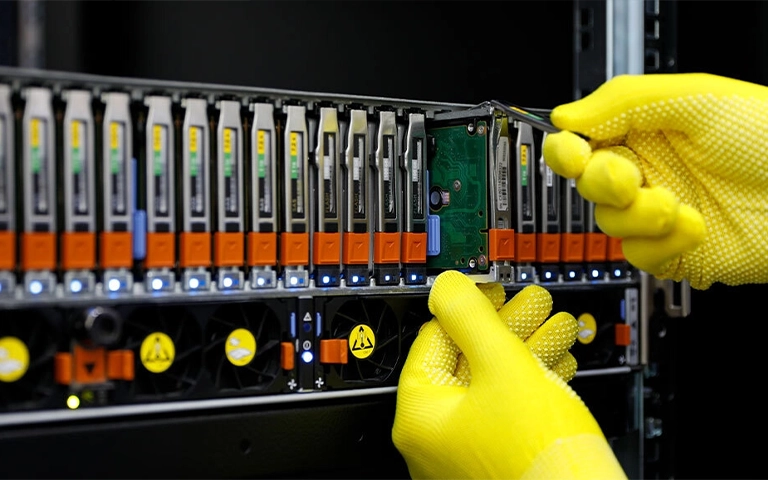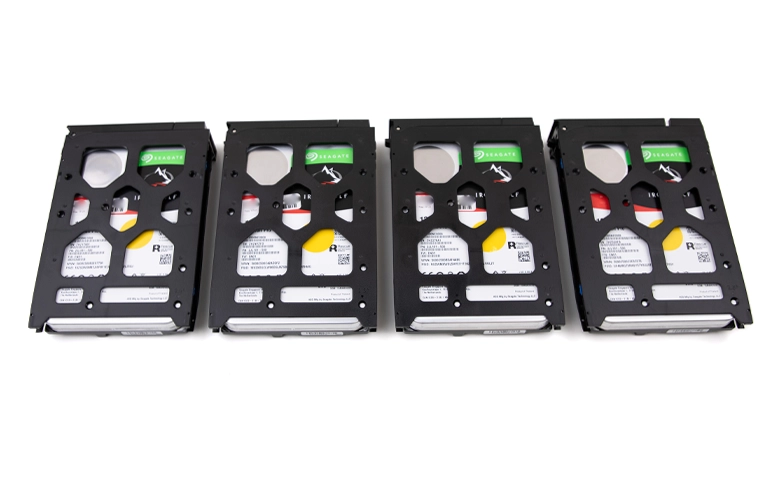RAID 50 is a hybrid configuration that combines the striping performance of RAID 0 with the distributed parity of RAID 5. The result is stronger resilience than pure RAID 0 and better throughput than a single RAID 5 set, making it a solid option for large data sets where balance matters.
In practice, you build multiple RAID 5 groups first, then stripe across those groups as a RAID 0 span. This delivers faster reads and writes while retaining fault tolerance. If one drive fails within a RAID 5 group, the array remains online while that set rebuilds. Note that RAID 50 requires at least six disks and capacity is reduced by one disk per RAID 5 group.
This layout is common in business environments where performance and data security must coexist, such as database servers, virtualisation hosts, media production, and analytics. It offers a pragmatic trade-off between cost, protection, and speed, which is why RAID 50 remains a popular choice for professional workloads.

How RAID 50 works
RAID 50 combines several RAID 5 arrays into a single striped RAID 0 set. Each RAID 5 group holds data and parity blocks that allow recovery if one drive in that group fails. The RAID 0 layer stripes data across those groups to raise aggregate read and write performance.
To deploy RAID 50 you need a minimum of six drives. A common build is two RAID 5 sets of three disks each, striped together as one array. Usable capacity equals the sum of all drives minus one disk per RAID 5 group, which is reserved for parity.
This design delivers both speed and fault tolerance. Striping improves throughput by spreading I O across multiple groups, while parity within each RAID 5 set maintains redundancy. Data loss can still occur if more than one drive fails in the same RAID 5 group before a rebuild completes.
Most RAID 50 systems are managed by a dedicated hardware controller. The controller handles stripe geometry, caching and parity calculations. Incorrect settings, outdated firmware or a failed controller can destabilise the array or make it unreadable.
Key features and benefits of RAID 50
RAID 50 offers a combination of high performance and reliable data protection, making it suitable for demanding environments. Below are its main advantages:
Enhanced performance: By striping data across multiple RAID 5 arrays, RAID 50 delivers faster reads and writes than a single RAID 5 set. It efficiently handles large transfers for databases, virtual machines, and media workflows.
Improved fault tolerance: Each RAID 5 group can tolerate one disk failure without data loss, maintaining availability while the affected set rebuilds.
Scalable and reliable: RAID 50 supports straightforward expansion and balances throughput with protection. It suits organisations expecting data growth or sustained heavy workloads.
Optimised for multi user systems: High aggregate throughput and stable I O make RAID 50 a strong fit for shared environments such as enterprise servers and central file storage.

Disadvantages and Limitations of RAID 50
Requires more drives: RAID 50 needs a minimum of six disks. Upfront hardware costs are higher, which is often impractical for small deployments or home users.
Complex setup and management: Configuration typically relies on an advanced RAID controller that supports multiple levels. Expansion planning, drive replacement, and firmware alignment add operational complexity.
Risk during multiple drive failures: The array tolerates one failed disk per RAID 5 group. If two drives fail in the same group before a rebuild completes, data loss can occur. Proactive monitoring is essential.
Longer rebuild time: Rebuilding large capacity disks can take many hours. During this window performance may dip and the array remains exposed to additional failures.
Higher cost per gigabyte: One disk in each RAID 5 group is reserved for parity, reducing usable capacity. Evaluate the trade off between protection and cost before selection.
RAID 50 vs Other RAID Levels
To position RAID 50 appropriately, compare its trade offs against common alternatives.
In practice, RAID 50 sits in the middle ground. It is faster than RAID 5 and RAID 6 for mixed workloads, while delivering stronger redundancy than pure striping. It performs particularly well with large I O profiles typical of data centres, virtualisation hosts, and high volume file services.
Learn more about RAID 5 vs RAID 6 and RAID 50 vs RAID 60 for deeper comparisons between related configurations.

When to use RAID 50
RAID 50 is a strong fit when you need both speed and data protection, and downtime is costly. It shines where sustained throughput, predictable latency, and resilience must coexist.
Common use cases include:
Virtualised servers: Runs multiple workloads efficiently with high aggregate read and write performance.
Database hosting: Improves query response while maintaining redundancy at the set level.
Media and video editing: Handles large sequential files and accelerates ingest, preview, and render cycles.
Enterprise storage: Scales capacity while preserving reliable fault tolerance and steady uptime.
Research environments: Supports smooth processing of large datasets and parallel I O pipelines.
RAID 50 is best deployed in professional setups with a capable hardware controller, validated firmware, and active monitoring. It balances speed, safety, and capacity for data driven operations.
Fast turnaround times for business-critical data
Dealing with RAID 50 failures
RAID 50 provides strong redundancy, but failures still occur through disk crashes, controller faults, firmware bugs, or configuration mistakes. Because the layout spans multiple RAID 5 groups, recovery is more complex than with single level arrays.
If two disks fail within the same RAID 5 group, the array becomes unreadable. Do not attempt ad hoc rebuilds, disk swaps, or filesystem checks. These actions can overwrite parity, alter metadata, and reduce the chance of a clean recovery.
When a fault is detected, power the system down and engage specialists. At RAID Recovery Services, engineers clone each disk in a controlled environment, reconstruct the array virtually, verify parity alignment, and extract data safely.
For deeper guidance, learn more about Troubleshooting RAID Failure and RAID Controller Failure Recovery to understand symptoms, escalation steps, and safe handling practices.

Conclusion
RAID 50 blends the speed of striping with the protection of parity, delivering strong performance under heavy workloads while safeguarding data from single drive failures within each group. Its balance of throughput, reliability, and usable capacity makes it a sound choice for organisations running critical applications and large datasets.
The same multi level design that drives its performance also complicates recovery. Unsupervised rebuilds or disk swaps can overwrite parity and corrupt metadata, reducing the likelihood of a clean restore.
If your RAID 50 array is degraded, inaccessible, or showing drive errors, engage specialists promptly. RAID Recovery Services manages the full process end to end, from safe disk imaging to virtual reconstruction and validated extraction, to maximise recoverable data in a secure environment.
Need help now? Contact RAID Recovery Services for expert evaluation and recovery support.
Trust the experts with proven results
Frequently Asked Questions
What is the main advantage of a RAID 50 array?
RAID 50 blends RAID 5 redundancy with RAID 0 striping. You get faster read and write performance while maintaining protection against a single disk failure within each RAID 5 group.
How many drives are required to build a RAID 50?
A minimum of six disks. Each RAID 5 group needs at least three drives, and you stripe across two or more groups to form the RAID 50 array.
What happens if two drives fail in the same RAID 5 group?
The array becomes unreadable and data loss is likely. Do not attempt a rebuild or disk swaps. Engage professional recovery to reconstruct the layout safely.
Is RAID 50 suitable for home use?
Generally no. The cost, drive count, and configuration complexity make RAID 50 better suited to servers, enterprise storage, and high performance workstations.
Can data be recovered from a failed RAID 50 array?
Often yes. Recovery is complex due to the layered structure. At RAID Recovery Services, engineers image each disk, rebuild the array virtually, and extract data using specialist tools.